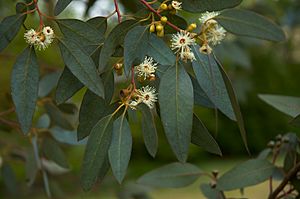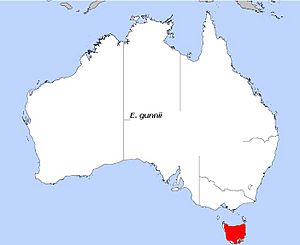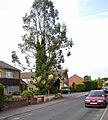Cider gum facts for kids
Quick facts for kids Cider gum |
|
|---|---|
 |
|
| Foliage and flowers | |
| Scientific classification | |
| Genus: |
Eucalyptus
|
| Species: |
gunnii
|
| Subspecies | |
|
|
 |
|
| Distribution | |
The Cider gum (Eucalyptus gunnii) is a type of tree found only in Tasmania, Australia. It's a small to medium-sized tree. It gets its name "cider gum" because its sap was once used to make a drink. This tree has smooth bark and unique leaves. It also produces white flowers and interesting fruit.
Contents
What Does the Cider Gum Look Like?
The Cider gum is a tree that can grow up to about 35 meters (115 feet) tall. It has a special woody swelling at its base called a lignotuber. This helps the tree regrow if it gets damaged.
Its bark is usually smooth. It can be mottled, white, or grey. Sometimes, the bark near the bottom of the trunk is rough.
Leaves, Flowers, and Fruit
Young Cider gum plants have leaves that grow directly from the stem. These leaves are arranged in opposite pairs. They are heart-shaped or round. They are also greyish-green or have a powdery, whitish coating. These young leaves are about 13-45 mm long and 17-40 mm wide.
Adult leaves are different. They grow one after another along the stem. They are shaped like a spear or an egg. Both sides of the adult leaves are a dull greyish or bluish-green. They are about 40-90 mm long and 12-35 mm wide. Each leaf has a stem called a petiole, which is about 9-23 mm long.
The flowers of the Cider gum grow in groups of three. They appear where the leaves meet the stem (called the axil). Each group of flowers grows on a short stalk, about 3-9 mm long. The individual flower buds are oval-shaped. They are about 5-9 mm long and 3-5 mm wide. Each bud has a cap called an operculum, which can be cone-shaped, rounded, or flat.
Cider gum trees can flower in most months of the year. Their flowers are white. After flowering, the tree produces woody fruits. These fruits are shaped like a cylinder or a barrel. They are about 5-9 mm long and 5-7 mm wide. These fruits are actually seed capsules.
How the Cider Gum Got Its Name
The Cider gum was first officially described in 1844. A British botanist named Joseph Dalton Hooker gave it its scientific name, Eucalyptus gunnii.
The tree was named after Ronald Campbell Gunn. He was a plant collector who found the first samples of this tree. He found them in the high tablelands of Tasmania, especially near the lakes.
People in Tasmania often call this tree "cider gum." In other parts of Australia, it's sometimes called "sugar gum," "white gum," or "swamp gum."
Where the Cider Gum Grows
The Cider gum grows in woodlands. You can find it on the plains and slopes of the central plateaus of Tasmania. It also grows on mountains made of a rock called dolerite. These trees can be found at high altitudes, up to about 1100 meters (3,600 feet). Some isolated groups of Cider gums also grow south of Hobart.
Growing Cider Gum in Gardens
This tree is very popular for planting in gardens. It has even won an award for being a great garden plant!
One of the best things about the Cider gum is how well it handles cold weather. It can survive temperatures as low as -14 °C (7 °F). Sometimes, it can even survive brief periods of -20 °C (-4 °F). Because of this, it's often planted as an ornamental tree (a tree grown for its beauty) in places like the British Isles and parts of Europe.
The Cider gum grows quickly. It can grow up to 1.5 meters (5 feet) taller each year. When it's fully grown, it can reach about 37 meters (120 feet) tall.
Caring for Your Cider Gum
You can trim the tree to keep it smaller, like a shrub, if you want. Growing it in shadier spots can also help limit its growth.
It can grow in full sun in sandy or chalky soils, as long as it gets enough water. However, it prefers a loamy soil, which is a mix of sand, silt, and clay. It doesn't like very wet places. The Cider gum is one of the toughest eucalyptus trees, along with the Snow gum and Small-leaved gum.
What the Cider Gum is Used For
The leaves of the Cider gum have a nice smell. They contain essential oils that are released when the leaves are crushed or burned. These oils are used in different ways. They can help treat breathing problems, muscle aches (rheumatism), headaches (migraines), and tiredness. They also act as an antiseptic, which helps stop germs from growing.
The native people of Tasmania used the sap from the Cider gum tree. They made a fermented drink from it called way-a-linah.
Gallery
-
Young specimen in Maranoa Gardens
See also
 In Spanish: Eucalipto de Gunn para niños
In Spanish: Eucalipto de Gunn para niños




